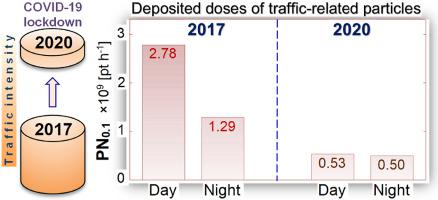Journal of Transport & Health ( IF 3.2 ) Pub Date : 2021-08-20 , DOI: 10.1016/j.jth.2021.101233 Bernard Polednik 1

|
Introduction
In 2020, due to the outbreak of COVID-19, there has been an unprecedented decrease in road traffic in almost all urbanized areas around the globe. This has undoubtedly affected the ambient air quality.
Methods
In this study mobile and fixed-site measurements of aerosol particle concentrations in the ambient air in one of the busiest streets in Lublin, a mid-sized city in Central Europe (Poland) during the COVID-19 lockdown in the spring of 2020 were performed. Based on the measurements particle doses received by road users during different times of the day were assessed. The obtained results were compared with corresponding pre-COVID-19 measurements also performed in the spring which were available only from 2017.
Results
During lockdown the mass concentration of traffic-related submicrometer PM1 particles and number concentration of ultrafine PN0.1 particles was significantly reduced. This resulted in a decrease of doses inhaled by road users as well as of particle doses deposited in their respiratory tracks. The greatest reductions of respectively over 2 times and over 5 times were observed during the day for total particles and traffic-related particles. Smaller reductions indicating the existence of relatively intensive non-traffic emissions were reported at night.
Conclusions
Substantial decrease in traffic intensity in the city caused by lockdown restrictions resulted in a significant reduction in the concentration of vehicle-generated particles in the ambient air. This in turn could have resulted in smaller doses inhaled by the inhabitants, specifically road users, which should have a positive impact on their health.
中文翻译:

COVID-19 封锁和道路使用者的颗粒暴露
介绍
2020年,由于COVID-19的爆发,全球几乎所有城市化地区的道路交通都出现了前所未有的减少。这无疑影响了环境空气质量。
方法
在这项研究中,对 2020 年春季 COVID-19 封锁期间中欧(波兰)中型城市卢布林最繁忙的街道之一的环境空气中气溶胶颗粒浓度进行了移动和固定测量。根据测量结果,评估了道路使用者在一天中不同时间接收到的颗粒剂量。将获得的结果与同样在春季进行的相应的 COVID-19 之前的测量结果进行了比较,这些测量结果仅从 2017 年开始提供。
结果
封锁期间,与交通相关的亚微米 PM 1颗粒的质量浓度和超细 PN 0.1颗粒的数量浓度显着降低。这导致道路使用者吸入的剂量以及沉积在呼吸道中的颗粒剂量减少。白天总颗粒物和交通相关颗粒物的最大减少量分别超过 2 倍和超过 5 倍。据报道,夜间减少幅度较小,表明存在相对密集的非交通排放。
结论
封锁限制导致城市交通强度大幅下降,导致环境空气中车辆产生的颗粒物浓度显着降低。这反过来可能会导致居民(特别是道路使用者)吸入较小的剂量,这应该会对他们的健康产生积极影响。











































 京公网安备 11010802027423号
京公网安备 11010802027423号